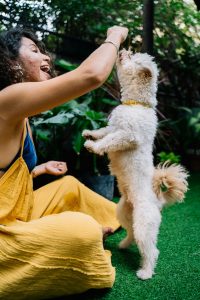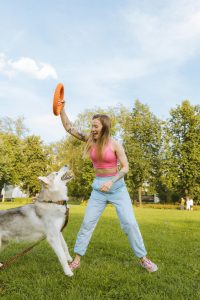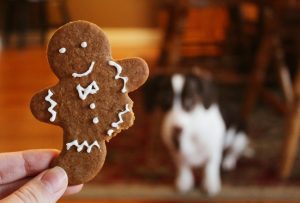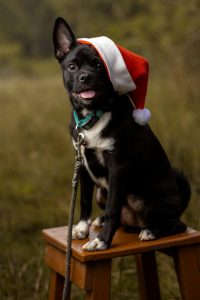Does your dog show signs of aggressive behavior? If that is the case, dog socialization can help vastly. There is no such thing as an aggressive dog. What might happen is your dog reacts to a certain trigger. No dog is aggressive per se and attacks people and other dogs just for the sake of attacking them. How to socialize aggressive dog?
Now, what you have to understand is the root of the problem. Why is your dog showing signs of aggression? What type of dog aggression is it? Leash aggression? Fear aggression? Territorial aggression? Or something else?
Today, we will try to talk about the triggers that can make your dog shows signs of aggressive behavior.
It is easier to socialize a young puppy. But even an adult dog can benefit from dog socialization. When you socialize your puppy, you improve its quality of life and create a happy and well-rounded sociable dog.
Why is my dog aggressive?
As I said before, there is no such thing as an aggressive dog. I can bet your dog is calm and relaxed for at least 80% of the day. So, what is the point I try to make? The goal of socializing is to introduce positive reinforcement and use it for good behavior.
And then, try to find the root of the dog aggressive behavior. Usually, aggression comes from a lack of socialization as a puppy.
There are a couple of reasons why your dog might show signs of aggressive behavior.
- Genetics, as in dogs with aggressive or fearful parents
- Breed, some dog breeds were bred for protectiveness, and suspicion of strangers, and they might become aggressive
- Adverse life experiences, are usually, the biggest reason for dog aggressive behavior
Sometimes, it is a combination of all three. But in my experience, the adverse life experiences, and here we put lack of socialization in that group, is the biggest reason for dogs showing aggressive behavior.
Any bad experience, no matter how minor, can affect your dog’s personality. Here is an example. A stray dog in my neighborhood had a bad experience with a guy with a bicycle. He hit her once, and since then, she started barking at all bicycles.
Milo has had a few experiences like that as well. You will hear a lot of dog owners their dog doesn’t like a certain breed. For example, Milo doesn’t like Akitas. He had a bad experience with one trying to attack him when he was a little puppy, and now, he barks from afar when he sees an Akita, male or female.
Difference between aggressive and aggression
I am all against putting the label aggressive on any dog. Why? Because as I said before, no dog is aggressive all the time.
What you can use is the term showing signs of aggression. For example, some dogs are suspicious of people, or fearful of little children, and they might growl when people try to pet them. That is due to a lack of socialization and exposure to different people. But it doesn’t mean the dog is aggressive.
The term aggression covers behaviors like barking, snapping, biting, lunging, and growling. But it is much better to use the term reactive. More on that below.
Difference between aggression and reactivity
Let me ask you a question any professional dog trainer will ask you if you ask for help for a dog with aggressive tendencies. Is your dog aggressive all the time? Or does he react to certain situations?
Well, I can bet it is the latter one, right?
That means your dog is not aggressive, he is reactive. And there are certain triggers that make him react to a specific situation.
Here is another example, Milo doesn’t like when a bigger dog puts its head over him. He is fine when dogs are sniffing him, but if another dog tries to put his head over him, he reacts. First, he growls, and then he might react.
That doesn’t mean Milo is aggressive. He reacts to situations that do not make him feel comfortable. What would you do if you are in a situation where someone makes you uncomfortable?
Why is your dog nervous around other dogs?
When we talk about socialization, it is important to note we are not talking only about dog-dog socialization. That is only like, 10% of the socialization part.
Now, your dog might be nervous around other dogs for three simple reasons.
The first one is a lack of proper socialization. It doesn’t mean you haven’t tried to socialize your puppy. It means you haven’t done the proper socialization.
For example, a lot of people think the dog park is the best place for socialization. But that is a wrong premise. So many things can go wrong in the dog park.
For one, if you have a fearful puppy, your pet might get even more anxious and nervous.
This brings us to reason number 2, anxiety. Dogs can have anxieties about different things. And sometimes, they are anxious around other dogs. Nothing wrong there. Just do not try to push your dog toward other dogs.
And the last reason, you are advocating for your dog. Always remember, your dog looks at you for leadership. And if you are anxious and stressed around other dogs, and if you are not acting like a calm leader, your puppy will react. And what you have is bad behavior that continues to happen, you do not work on the aggressive tendencies, and your dog is labeled as an aggressive one.
What is dog socialization?
When we talk about how to socialize aggressive dog, we have to talk about what socialization actually is. A lot of people think that socialization starts and ends with meeting and greeting other dogs. Like, go to the dog park, let your puppy play, and that is it.
Wrong. Proper socialization is much more. Here is a breakdown of all the things you need to do to socialize your dog.
- Exposure to different sounds
- Exposure to different smells
- Exposure to novel sighs and objects
- Experiencing various floor materials
- Experiencing different types of handling and touches
- Visiting novel buildings
- Meeting dogs
- Meeting people
- Meeting adults
- Meeting children
- Maintaining focus around different animals
- Maintaining focus around unfamiliar people
Understand your dog’s triggers
Now let’s talk about how to socialize aggressive dog. As I said before, there is no such thing as aggressive dogs. There are triggers that will make your dog react. And if you have an unsocialized dog, chances are there more triggers.
What are these triggers? They can be anything from objects, people, and even situations that will set your dog off. Here is an example, Milo can sometimes bark at big, round, and unevenly shaped objects outside. Since I cannot predict each object, and cannot socialize him with every object, I always try to use positive reinforcement when we pass such object he reacts to.
Remember, he is a small dog, a Jack Russell terrier, so big objects look scary to him.
Some of the common triggers include men in hats, bicycles, an unfamiliar dog, and some other dogs pulling the leash toward your dog.
How to socialize aggressive dog?
There are four different techniques you can use to turn an unsocialized dog into a confident dog. Let’s try and break them down.
Shaping
Simply put, shaping is reinforcing small actions the dog makes toward the big goal. For example, if your goal is to have your dog calmly pass and sniff another dog, you reinforce things even before the two dogs meet.
For example, you reinforce calm behavior as your dog is sitting and waiting for the other dog. And as the other dog approaches, you reinforce calm behavior again and again. And then one sniff, reinforce, continue your way.
Desensitization
This is another technique you can use to socialize your dog and stop reactivity. What is desensitization? The best way to explain it is systematic exposure to something that used to scare them. The longer and the more frequently you expose your dog to the same trigger, he will react less frequently.
Here is a common example. Milo can sometimes bark when we pass a dog in a yard. We pass the yard once, then again, and again, and again. And by the fourth or fifth time we pass the same dog, neither Milo nor the dog in the yard bark at each other.
This is possible with other objects that can scare your dog. Remember, we said dog socialization is much more than just exposure to other dogs.
Counter-conditioning
This technique tries to pair the presence of other dogs with pleasant things. The best example would be playing with a toy your dog loves.
For example, I often bring a ball with me on walks. When I see another dog, and I assume Milo might react and that dog might come to Milo, I pull out the ball, and have it in my hand so Milo can focus on me and the ball. We pass other dogs, and Milo doesn’t react.
Or another example, since Milo is scared of thunderstorms and fireworks, I try to make it as pleasant as possible. How do we do that? We play as hard and as much as we can when there are fireworks. It takes his mind off the fireworks.
He might never associate fireworks with something pleasant, but he will ignore them and play with his favorite toy.
Offering different behavior
If you ask professional dog trainers, they will tell you the essence of dog training is to know what your dog does bad and come up with something good to do instead.
For example, if your dog barks when someone rings at the door, you should answer the question what do you want him to do instead? And positively reinforce that behavior and train your dog to do that behavior on cue instead.
If you want to use it for a dog showing aggressive behavior, train your dog to sit and look at you when other dogs pass by. But you have to make sure that paying attention to you is worthy and rewards your dog with something amazing.
More tips
Let’s finish off with a few more tips on how to turn your pet into a confident dog that will not react.
- Schedule play dates or walks with friendly dogs
- Do not discipline your dog with leash jerks when they react. You are only making matters worse
- Remain calm in a situation your dog reacts
- Change your behavior, your dog sees you as its leader and family. If you are scared, your dog will become protective and show signs of territorial aggression
- Do not allow your dog to pull on a leash, it will result in leash aggression
- Make your walks a routine to calm your dog and socialize him with the environment more easily
- If all else fails, take your pet to growl class and dog training class







